

COMPETENCES FOR THE 21ST CENTURY SCHOOLS. Each of the approaches to understanding of 21st century skills and how they fit with our notions of education and the function it serves, emphasises skills that diverge from modern traditional notions of academic disciplines.
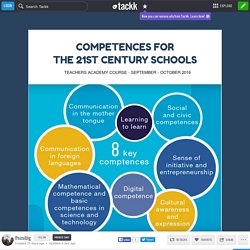
They all actually identify enabling skills - skills that we need to navigate our global society. They converge on a common set of 21st century competences - collaboration, communication, ICT literacy, and social and/or cultural competencies; and most include creativity, critical thinking, productivity, and problem-solving. Collaborative problem solving is a complex skill requiring both social and cognitive competencies. It was rationalised by the ATC 21S project team as a composite skill arising from the links between critical thinking, problem solving, decision making and collaboration. Collaborative problem solving is a set of skills that we need to rely on when the capacities or resources of just one person are not sufficient to solve the problem. Learning Diaries and Learning Designs (Responses) - Hojas de Cálculo de Google.
Project -Based Learning Teacher Academyhere's my diary....... 2.2 WHAT IS EFFECTIVE COLLABORATION ?
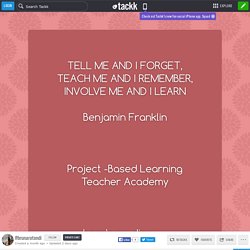
In the video " Collaboration" Deidre Butler refers to 21st Century Learning Design Rubrics which can help teachers to understand if they are really fostering collaborative learning in the classroom. Viewer - Learning Designer. Beginning 20 minutes) Teacher ask: Which could draw out?
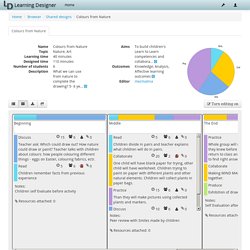
How nature could draw or paint? Teacher talks with children about colours: how people colouring different things - eggs on Easter, colouring fabrics, ectr. Children remember facts from previous experience Notes: Children self Evaluate before activity Resources attached: 0. Kristina Bernane's Learning DiaryProject-Based Learning My Learning Diary - Project Based LearningModules 3 and 4.
10 Tips for Building Resilience in Children and Teens 1.
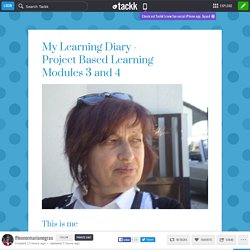
Make connections -Teach your child how to make friends, including the skill ofempathy, or feeling another’s pain. PBL course by SchoolEducationGateway - learning diary in the PBL course. PBL Course - Module IV. Viewer - Learning Designer. Integrate the students' cultural and country information into the weekly classroom routines 270 minutes) Every Syrian refugee student of the group will present in a language the others can understand, his/her country, speak about customs and traditions they have.
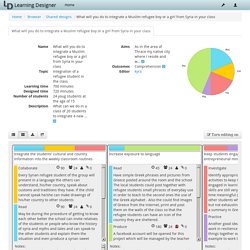
If the child cannot speak he/she can make drawings of his/her country to other students May be during the procedure of getting to know each other better the school can invite relatives of the students or people who know the history of syria and myths and tales and can speak to the other students and explain them the situation and even produce a syrian sweet which can be distributed to the other students. Each of the four groups could find information about Syria and bring them to the classroom where for 30 minutes every week could present their findings to each other. the refugee students could also speak about the reasons they had to leave their homeplace.
Resources attached: 4. A Learning Diary. 1.5 The Driving Question According to John Mergendoller of the Buck Institute for Education, such a project should contain "non-Googleable Driving Questions".
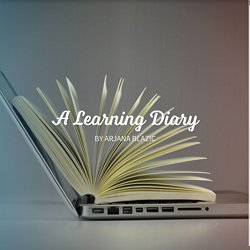
Mergendoller defines non-Googleable Driving Questions as driving questions to which answers can't be googled.His examples of Googleable questions are: "Who were the first settlers in our city? ""What does it mean to be a healthy eater? ""How are airplanes wings constructed? " Barbara' s Learning Diary. Introducing Project-Based Learning in your Classroom06.06.16. 1.

A Need to Know Teachers can powerfully activate students' need to know content by launching a project with an "entry event" that engages interest and initiates questioning. An entry event can be almost anything: a video, a lively discussion, a guest speaker, a field trip, or a piece of mock correspondence that sets up a scenario. UPDATING MY LEARNING DIARY. My reflections on the course pbl.What have I learned so far?
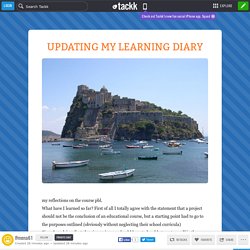
First of all I totally agree with the statement that a project should not be the conclusion of an educational course, but a starting point had to go to the purposes outlined (obviously without neglecting their school curricula)Since I work in a first class in a primary school I have to be able to put myself in the children'world from their own needs., Even more so I you want kids to guide the educational-didactic project according to the pbl. Because I live on an island, for a real connection with the world my driving question would be: why the sea is important? This question would be the coret of llearning because children should ask and give answers. My learning diary. My own driving question Context My PBL is for my classes of Portuguese.
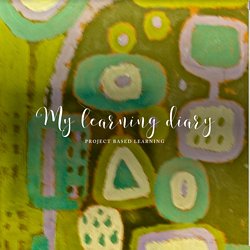
They are 10-12 year old pupils. The classrooms are spacious and all of them have a computer and a data show. Most of the kids have smartphones that up to the moment aren't allowed to use in the classroom. Learning Designer explained - My Learning Diaries. Christos PapachristodoulouLearning Diary. As an ICT (Computer) teacher the teaching method that I use is learning by doing.
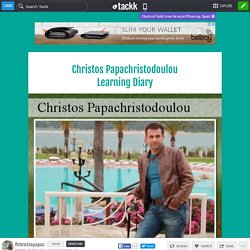
Computer classes requires practical work in order to learn. Without a practical involvement it’s not possible to learn. Computer teachers in Cyprus have the advantage to have their own labs with computers so learning process is most of the time practical. Most of the time I spent the first 5 mins to encage the students to the new subject/topic. Then the necessary knowledge is given to students through a Power Presentation or a practical example (15 mins) and the remaining time (20 mins) it is used by students for practical work. Most of the time students participate in the discussion of the topic and apply what they learn on computers. PBL course - Teacher academy. I am Carmen, a foreign language teacher and I have been teaching since 1992. since I love more studying than doing other thing, I decided to do this course as seriously as I can, so I had to wait until now to have little time to do "my homeworks" in the best way.
During the last 10 years I completely found the real way I want to teach. It was thanks to Etwinning, and I would not like to repeat what was already said about it, but with Etwinning I understood that I was not so far from a different way of teaching very close to actual students'needs and what I want to do in my classroom. So, who knows what Etwinning means or who is finding it out just now can understand perfectly what I want to mean. Learning Diaries and Learning Designs (Responses) - Google Sheets. Maria's Theodoridou Learning Diary.
A few things about me... My name is Maria Theodoridou and I am a primary school teacher for the last 14 years. I have taught in many different schools in Greece but I also taught Greek in Sweden for 3 years... it was an eye-opening experience for me! My learning diary. Francesca's Learning Diary. Hello everyone, my name is Francesca, I live in France but I’m Italian. I am a teacher and instructor of Italian as foreign language in a secondary vocational school in Lyon. My students are aged from 14 to 17 and they study English and Italian as foreign languages. My favourite hobbies are reading, travelling. Giovanna's Diary. Learning Design for: P2P reflection on our current teaching practice Context Topic: Castle defenses Total learning time: 25 minutes Number of students: 18 Description: children are given three links on three different castles. Aims. LEARNING DIARY PBL COURSETeacher Academy. Now, has a project hit the standards?
Is the product authentic? How is the presentation? Multiple Forms of Assessment "We know that the typical multiple-choice and short-answer tests aren't the only way, or necessarily the best way, to gauge a student's knowledge and abilities. Many states are incorporating performance-based assessments into their standardized tests or adding assessment vehicles such as student portfolios and presentations as additional measures of student understanding. These rigorous, multiple forms of assessment require students to apply what they're learning to real world tasks. With these formative and summative types of assessment come the ability to give students immediate feedback.
My PBL Learning Diary. Which of the 5 components (or keys as they are called in the video) you feel will be the most challenging for you to realize and why? Is it effective collaboration because your classroom space does not lend itself well to group work? Or is it assessment because your curriculum requires very regular and rigid summative assessments that you are worried will get in the way of PBL? Or maybe you are more concerned about the passivity of your students in lessons and getting them to take the initiative? This is my summary of this video: 1. 2. 3. 4. 5. If you want to see my Padet contribution press the button.